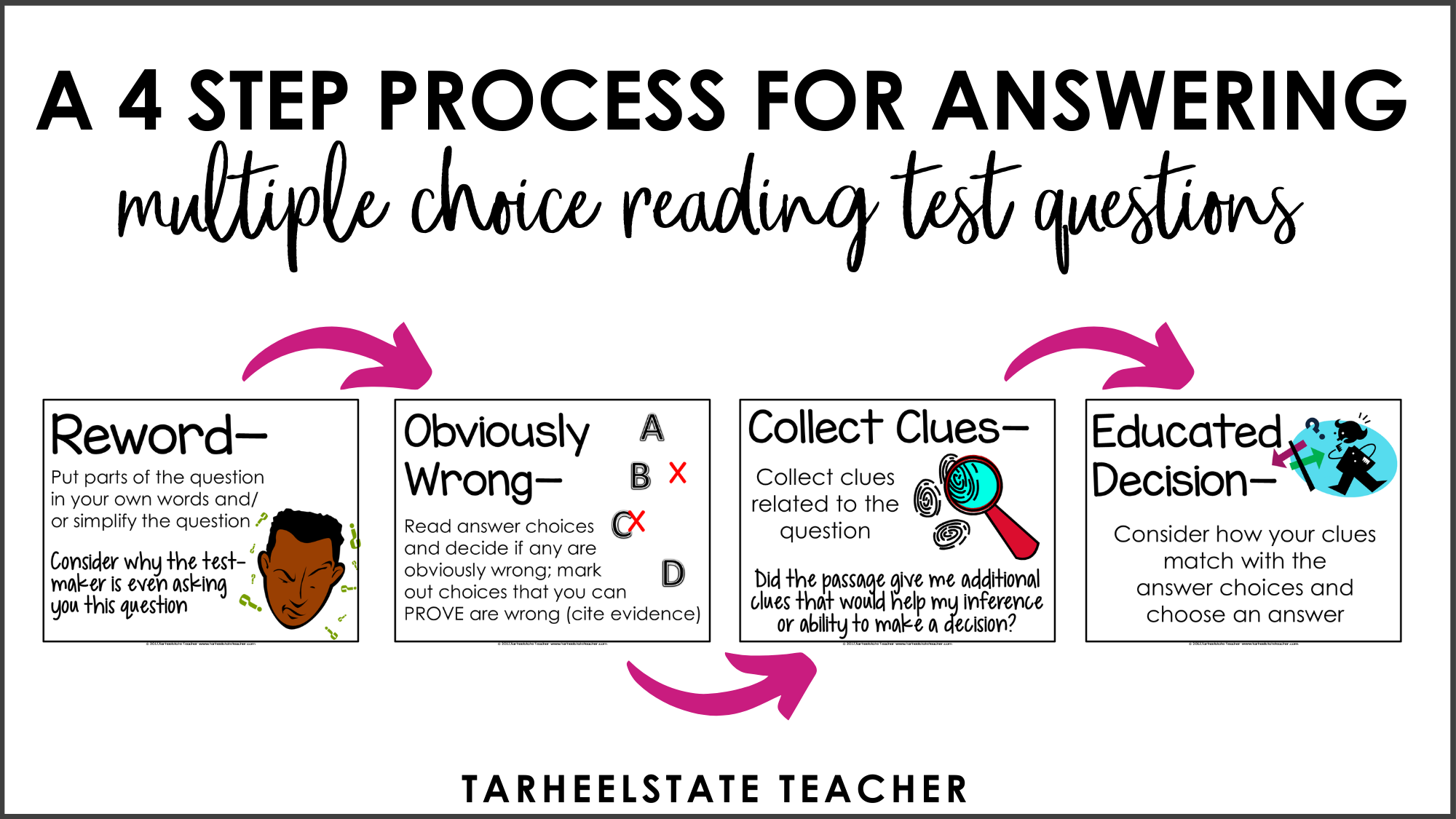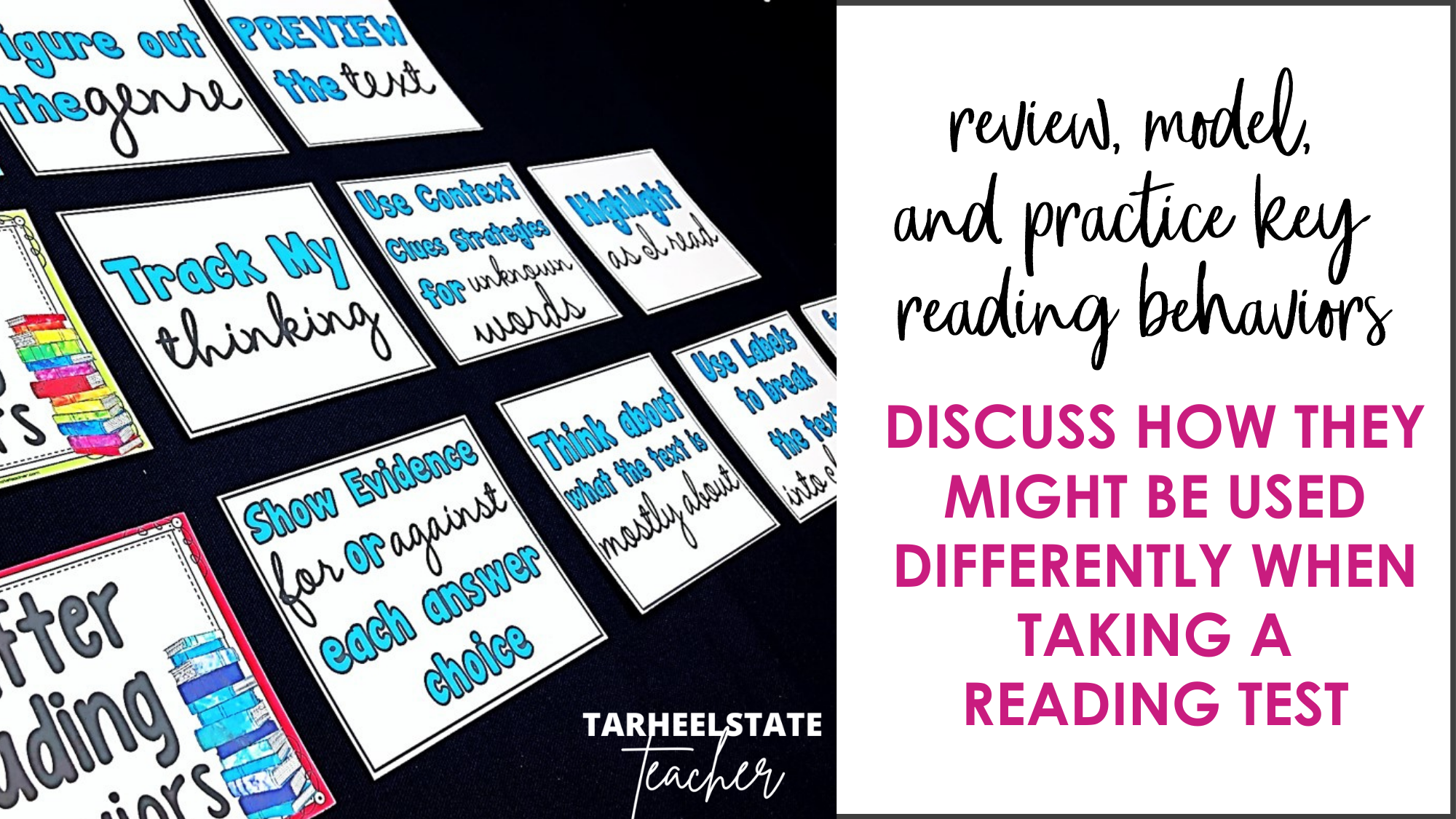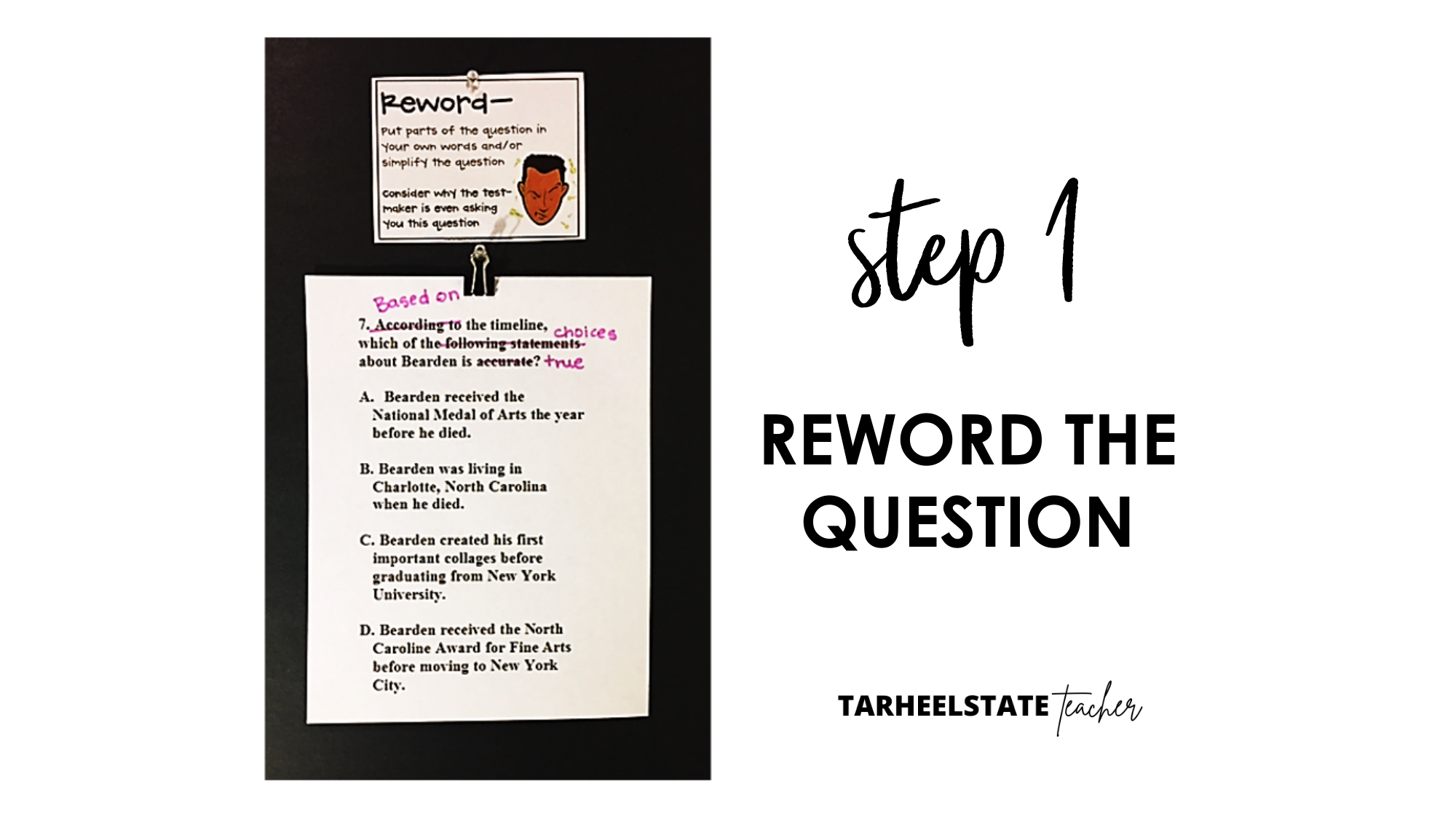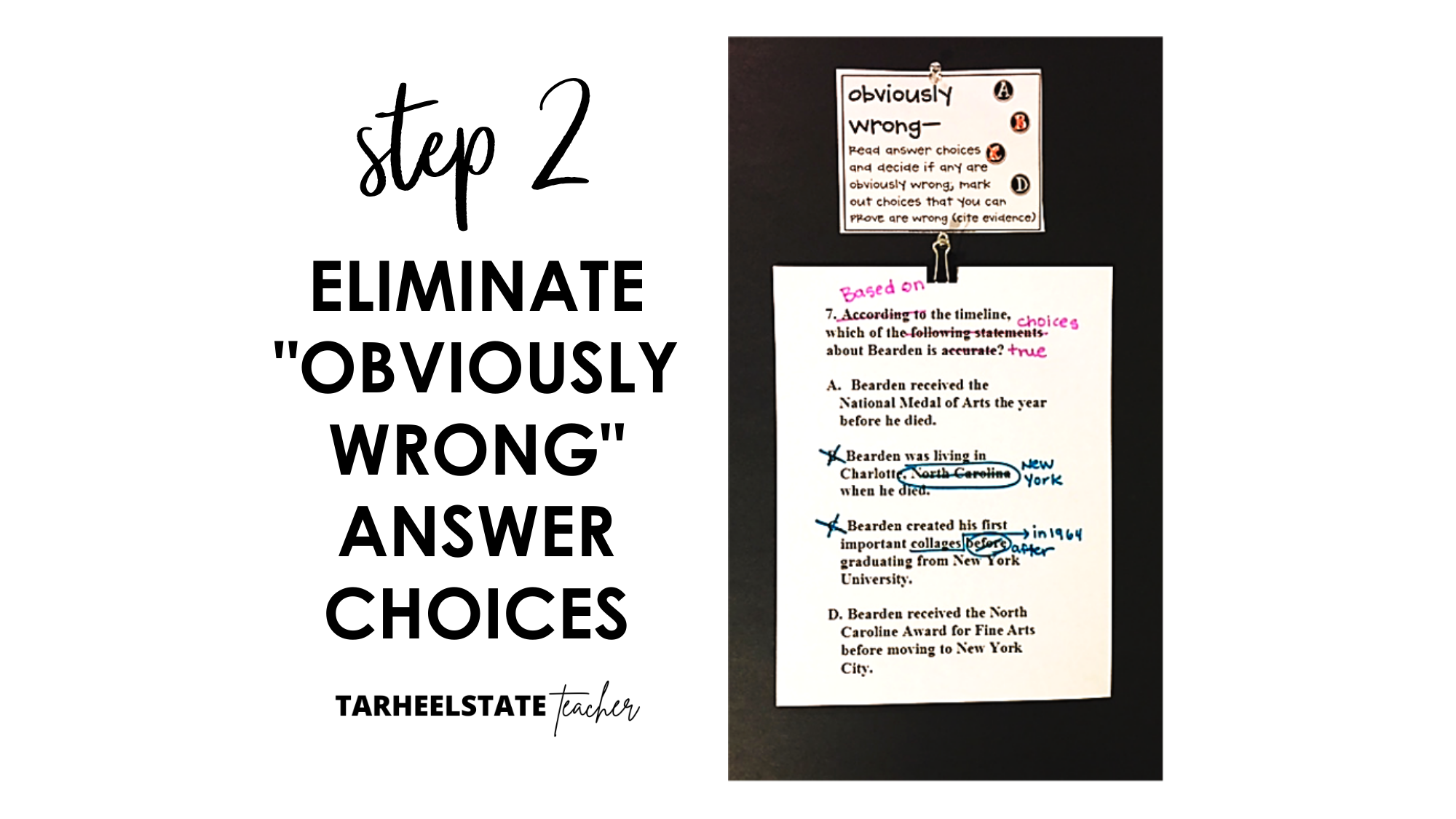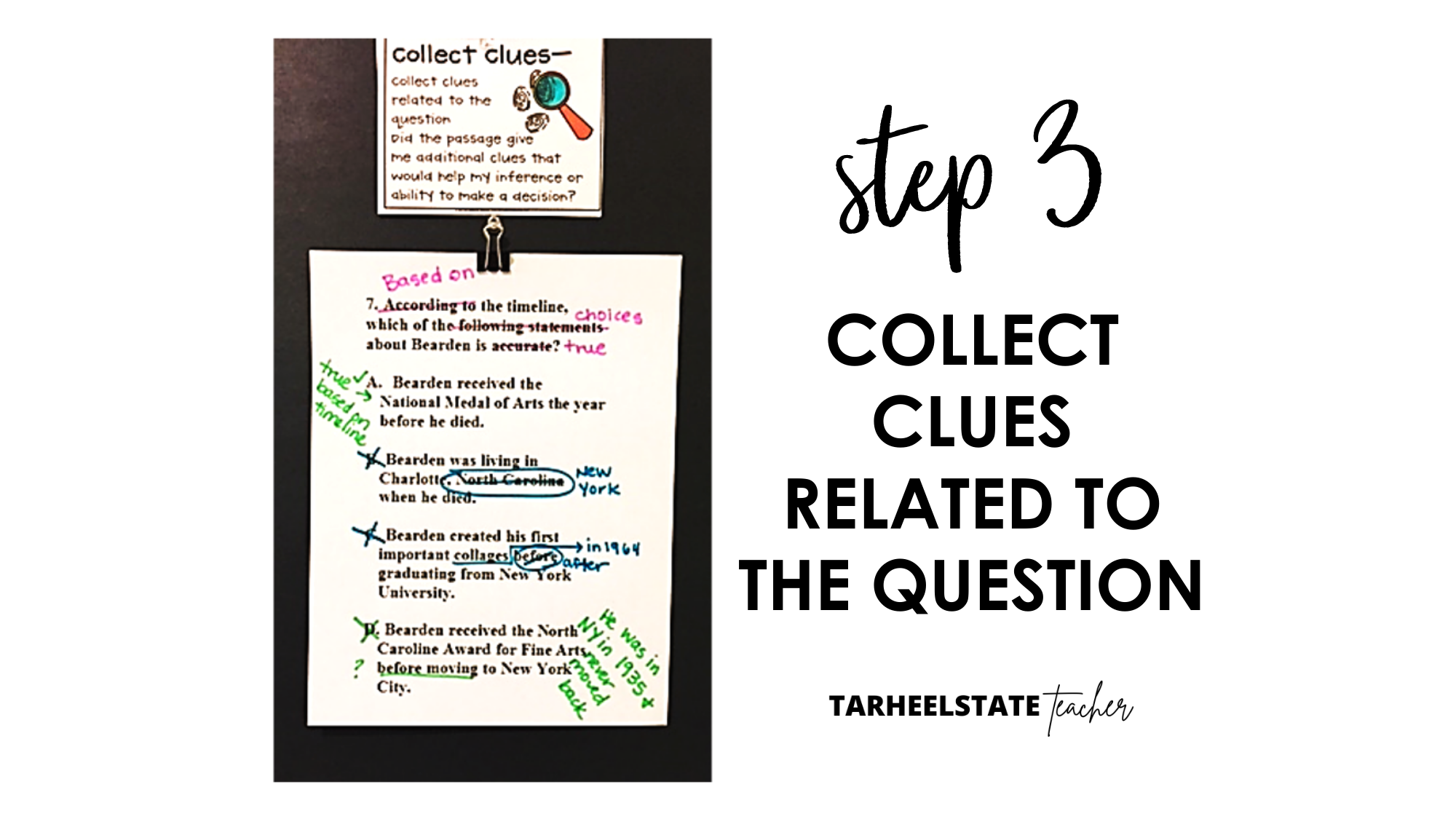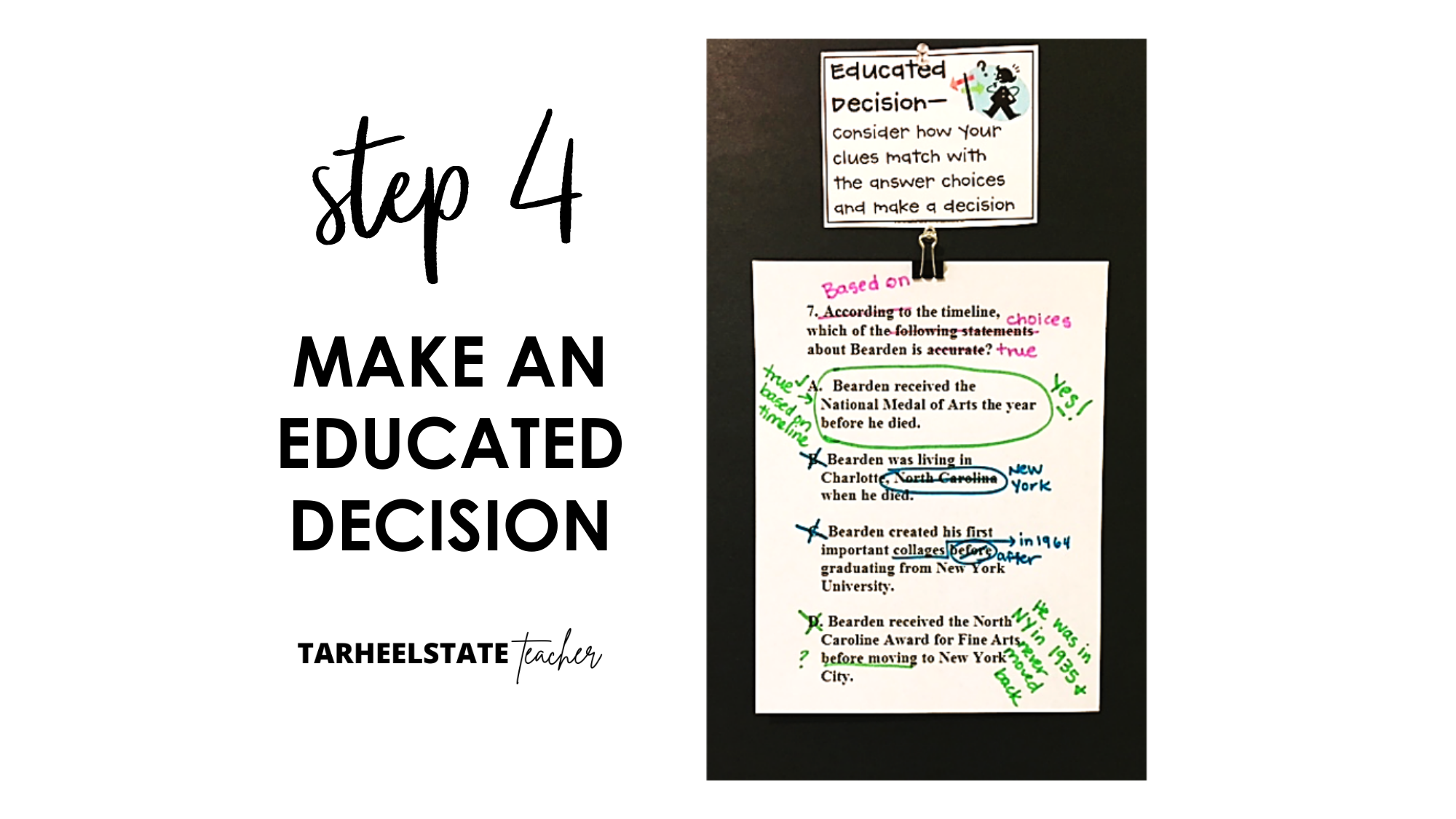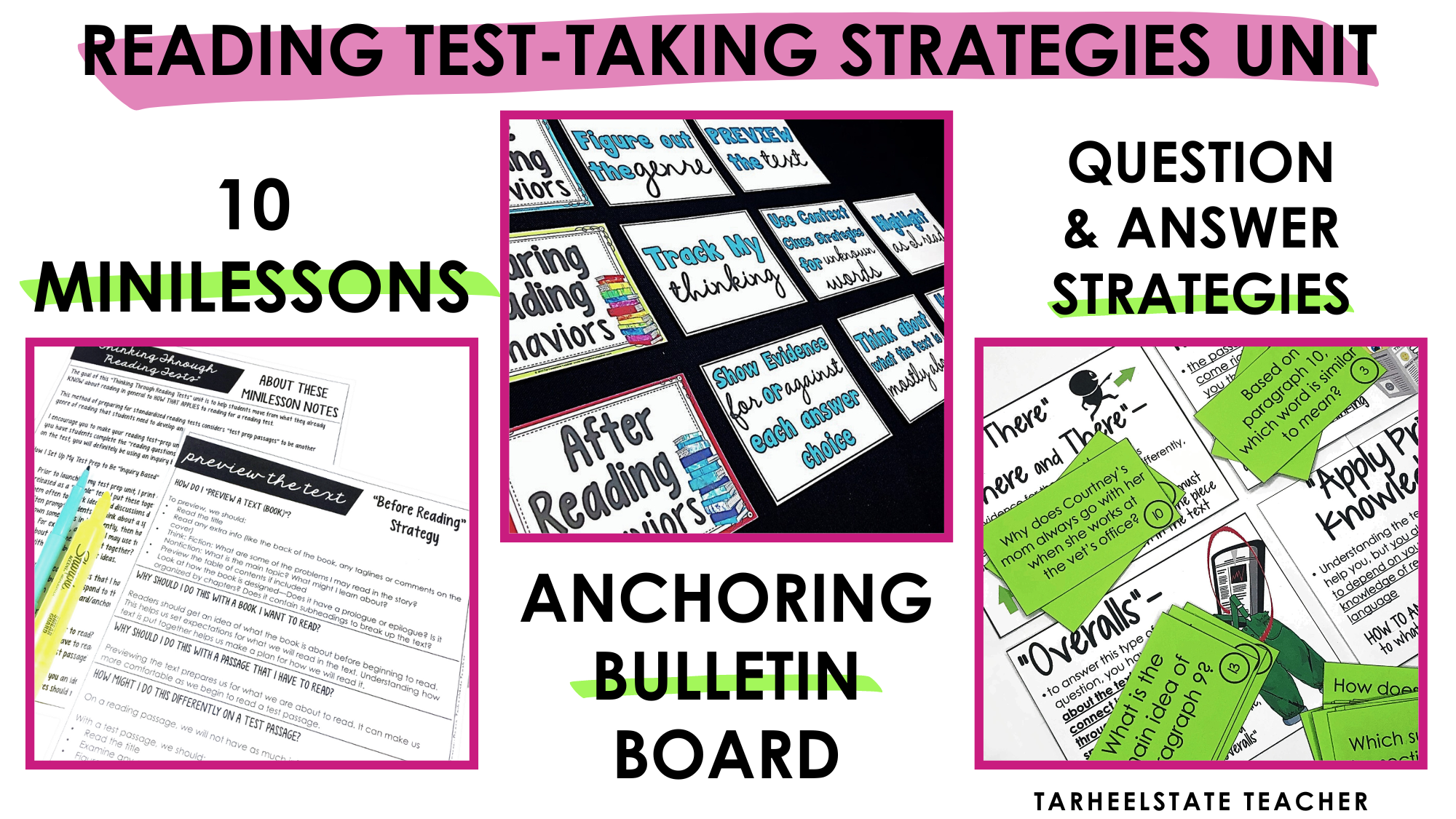A 4 Step Process for Answering Multiple-Choice Reading Questions
Do your students think that answering multiple-choice reading questions is all about making neat, dark bubbles on their bubble sheets? I hope not! But if so, let's give them more multiple-choice ELA test-taking strategies right away!
Once you have helped students connect what they know how to do when reading with how that applies to taking a reading test
AND taught them to analyze the type of question they are being asked, what strategies can you teach students for actually answering multiple-choice reading questions?
Today, I'm sharing my 4-Step process for answering reading questions that I teach my students each year before our end of grade reading test. This is one of the lessons found in my Thinking Through Reading Tests Framework.
Before I teach my 4-step process, we do a lot of work with our sample passages. I choose to review a focused set of strategies and expect my students to use them rather than review every reading strategy I possibly can and have them forget to use any of them.
⭐ If you are in need of reading comprehension test prep passages with multiple-choice questions and answers, I've got a list of free printable ones for you right here!
We review how to preview a text, "how to highlight effectively" (or underline) to note important information, track our thinking as we read, create chunks and add labels to larger texts to break them up into sections, and discuss how to use context clues to deal with unknown words.
I usually use one or two of the same passages again and again to model each of these reading behaviors and then have students practice with a fresh passage. As they are working, I monitor and take note of who is using the strategies and who is not. We discuss what I saw again and again to encourage students to do what they have been taught.
I have my students go through the reading behaviors with multiple passages before I have them read and answer any questions because
I want to make sure they understand my expectations for how they are supposed to read the text BEFORE we worry about answering questions.
I teach students that their job is to FULLY comprehend the text
{yep, see the crazy handwriting on the bottom of that anchor chart}.
If you've read other posts in this series, I've said this before, but it is just so important to reiterate. I don't want my students to think that the test is all about answering questions. The test is all about comprehension and they need to use all of their ELA test-taking strategies to comprehend the text first.
The 4-STEP PROCESS for ANSWERING MULTIPLE-CHOICE READING QUESTIONS
When it is time for me to teach my students how to answer reading questions, I lead them through a 4-step process that I came up with a few years ago. In this process, I model how to:
reword the question,
analyze answer choices and mark out 1-2 choices that are obviously wrong (probably because the choice clearly says something different than what is said in the text),
collect clues (or evidence) from the text related to the other answer choices, and
then make an educated decision about which answer is the best.
Day 1 Mini-lesson: STEP 1-REWORD THE QUESTION
Using the passages that we have read again and again in our skill lessons, I model rewording the questions with 1-2 examples.
This sounds so easy, huh? Well, I sometimes find that when my students try to simplify a question, they change the meaning of what was intended a bit. If the question is more direct, like "What is the main idea of this passage?" Students can reword the question to incorporate our QAR language and to help remind themselves of how they should answer this type of question. A rewording might be, "What is this story/article about OVERALL?"
I also teach students to think about why the test maker/author is even asking us the question.
Let's use a question for an example that is a bit more complicated. In one of the passages I like to use, the question states,
"According to the timeline, which of the following statements about Bearden is accurate?"
Why might the test maker be asking us this question?
to see if we read/looked at the timeline
to see if we know how to read and interpret a timeline
to see if we understand chronological order
to see if we can make inferences when reading a text feature
to see if we can use the information in a text feature to gain a deeper understanding of the text itself
Obviously, we are just hypothesizing here, but I think it's important to get students to realize that someone MADE UP these questions in order to try to get them to do something with their reading skills. I also think that hypothesizing about why the question is being asked helps students reword the question. I may reword this question by asking, "Based on the timeline, which of the choices is true about Bearden?" or "By looking at the timeline, which of these choices is a true statement?"
At the end of this lesson, students work in partners to practice rewording a few other questions for that passage. I pay attention and pull any rewordings that changed the meaning of a question into our closure for us to discuss as a group.
Day 2 Mini-lesson: STEP 2-ELIMINATE "OBVIOUSLY WRONG" ANSWER CHOICES
The next step is all about reducing our answer choices. We read through the choices and decide if any are "obviously wrong."
Given the same passage as we used in the previous lesson, my think-aloud goes something like this...
“Looking at question 7, B and C are obviously wrong because they contradict information that is given on the timeline. For B, the timeline says Bearden was living in New York City, not North Carolina. For C, the timeline shows that Bearden created his most important collages in 1964, many years AFTER graduating from New York University. I can eliminate B and C.”
“Now, I feel like A is the answer, but I don’t have enough proof to mark out D. I need to collect more clues.”
STEP 3-COLLECT CLUES RELATED TO THE QUESTION
In step three, I teach students to collect clues related to the question and decide if that piece of evidence supports an answer choice or disproves it.
"To collect clues, I ask myself "What clues and information did the passage give me to help me think about this question? Answer choice A says Bearden received the National Medal of Arts the year before he died....The timeline shows me this is true...I'm going to jot that down and put a little check beside of answer A.
Answer choice D says Bearden received the North Carolina Award for Fine Arts before moving to New York City...Well, he was in New York city in 1935, and it never tells me he moved back to NC.
The passage tells me “Afterward (college), Bearden became a social worker in New York City. He worked as a social worker on and off for more than 30 yrs. In the last section, the author lists a bunch of awards that Bearden received. I think the NC award is just another one he got, but not necessarily when he was living in NC.
STEP 4-MAKE AN EDUCATED DECISION (NOT A GUESS!)
So, I am now thinking answer choice D is wrong, and maybe even the distracting answer that might trick me. Another way I may have chosen answer D is if I didn’t pay attention to the question saying “According to the timeline.” Now that I think about it, answer A works BEST because it is according to the timeline."
I go through this think-aloud process with a few of the questions that felt "tricky" to me so that students and I can process them together. I encourage you to go through this process with a few test passages and plan to do a "think-aloud" to model how you would go through the 4-Step process with the questions yourself.
BY THE WAY...
I teach students to jot down notes beside of the answer choices and I make this an expectation when they are completing practice passages.
I want to SEE their thinking. I want the text to look like it has been read!
To enforce this during our test prep unit, I will not check a student's work if he/she has not shown evidence of using the "while reading" strategies and shown evidence for his/her answers. Sure, some students may groan about having to show all of this thinking, but it is my job to teach them strategies and expect them to practice them!
DAY 3-CONSOLIDATE STEPS AND PRACTICE AGAIN
On day 3, I use my minilesson time to consolidate the 4-steps of the process. I choose one more question to model rewording the question, eliminating "obviously wrong" choices, collecting evidence, and making an educated decision.
Once you have taught this in whole group, you can have students work independently and then share what they thought for each step with a partner. You can use your small group time to model the process again and again for students who need more practice and you can continue to bring it all back to the point...
→ How do each of these steps help us better answer the questions?
The first year that I implemented this process, I found that it made an amazing impact on my students. I especially remember an ESL student who had such a big smile on his face and expressed how much it helped him understand what to do when answering the questions. (During this year, I was teaching 4th grade and would loop to 5th the next year with the same students).
I've found that this test taking strategy forces students to refer to the text more and often, students who did not comprehend a text the first time they read it will "fix-up" some of their comprehension issues by going through this process. #worthit
The big point here is that many students think that "reading the answer choices and deciding on the best choice" is what they are supposed to do.
The directions given when administering the NC EOG actually say something like that...
"Read each question and all of the answer choices. Choose the best answer. Fill in the circle on your answer sheet with the best answer. Make a dark mark that completely fills the circle....."
WAAAAAIT a minute...
I wish I could express that sound of a record player screeching to a halt through my blog words......
But since I can't, I will just say, now do you see why students think the test is all about reading the choices, choosing an answer, and making a dark circle? I always CRINGE when those words come out of my mouth as a test administrator.
Those are TEST DIRECTIONS, not a process to go through.
So, as you embark on your reading test prep journey this year, I hope you can make it a little more inquiry based and provide your students with relevant strategies for being smart test takers who can "think through" a reading test and the questions they must answer.
Want to grab my minilesson framework for teaching and reviewing reading strategies, the QAR question analysis handouts, and the posters for the 4-Step process I have my students go through when answering reading questions?
Or share your email below to receive the first two reading test-prep minilessons for FREE!
And, Make Sure You Haven't Missed Anything and Stay Tuned for these Upcoming Posts
→ A Framework for Preparing for Standardized Reading Tests
→ Sorting Reading Questions Activity (to launch your reading test questions unit)
→ Reading Test Prep Mini-Lessons (an overview of the lessons I teach)
→ 4-Step Process for Answering Multiple Choice Reading Questions
→ Should we Teach Students to Read Questions First as a Test Prep Strategy? (Read why I don’t think so!)

